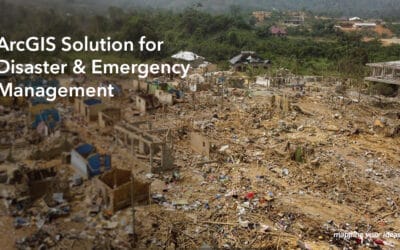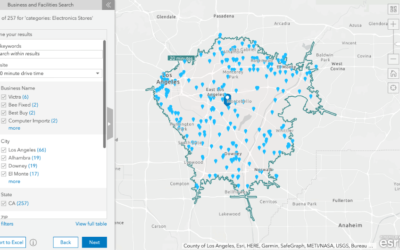Oilfield Ground Displacement Monitoring Using SAR Data
Activities to extract oil and gas, as well as those from underground mining, are a cause of ground displacement. These activities often include the extraction of groundwater or the injection of geothermal fluids, which can lead to gradual land subsidence (a slow sinking of the ground), putting the stability of buildings, infrastructures, or pipelines at risk for landslides or geotechnical failures. Monitoring the spatial distribution and temporal changes of ground-displacement patterns is crucial for the stability and risk mapping of critical assets in extractive industries. Anomalous displacements must be identified and analyzed rapidly to avoid the risk of damage, collapse, and ultimately life-threatening accidents.
Problem
Terrain deformations pose a significant concern for onshore oil and gas exploitation industries. Extraction activities at oil and gas reservoirs can cause land subsidence, often with high spatial variations, putting the structural stability of wells and boreholes at risk. In the case of fluid injection which is often used to increase the efficiency of the extraction, significant uplifts can occur, indicating low efficiency of the process. This means there is not only a safety aspect of inspection to avoid geological hazards and consequent damages to oil and gas infrastructure, but also a commercial interest to achieve more effective exploitation.
Monitoring large oil and gas fields, which can cover several hundred km², for millimetre-scale surface deformations is challenging, time-consuming, and expensive using traditional monitoring methods. GPS station point monitoring is accurate but does not provide a high-spatial distribution of measurements since only a limited number of points can be obtained over an area of interest. While levelling is highly accurate, it only permits limited repeatability over time, and only sections can be acquired at any one time. So, while both systems typically play a key role in monitoring, maintenance, and risk mitigation strategies, they cannot provide real temporal and full spatial coverage of ground displacements at reasonable operational costs. Further, on-site surveying comes with a multitude of safety concerns.

Figure: Automatically detected well pads in Texas from high-resolution optical satellite imagery using ENVI® Deep Learning software (Source: L3Harris).
Solution
Satellite SAR Interferometry for Ground Displacement Monitoring
Satellite remote sensing and geospatial technologies have been rapidly advancing, and today space-based earth observation using Synthetic Aperture Radar (SAR) provides an efficient, accurate and low-cost approach for risk and stability monitoring of priority areas such as critical infrastructure, construction sites, mining areas, and oil and gas fields. Spaceborne Differential Interferometry SAR (DInSAR) is a remote sensing technique that is exceptionally useful to measure sudden land deformations at two points in time, such as before and following an earthquake. But when it comes to slow-moving ground deformation phenomena such as material compaction, land subsidence or surface creep, it is essential to move to advanced, multi-temporal interferometric stacking techniques that can provide higher accuracies.
In general, there are two kinds of SAR Interferometric Stacking techniques that are applied today. The Persistent Scatterers (PS) method is used for monitoring localized structures (typically man-made features such as buildings, bridges, dams, etc.). The Small Baseline Subsets (SBAS, or Distributed Scatterers) method monitors extended areas like open fields, natural features, or other types of non-geometrically characterized objects. The advanced PS and SBAS Interferometric Stacking techniques analyze time series radar images to obtain a comprehensive overview of the spatial distribution and temporal evolution of slow terrain movements over large areas and long, multi-year periods of time, with millimetre sensitivity.
Unlike passive optical remote sensing sensors that can only operate in daylight when the sun is shining, SAR systems provide their own energy source, allowing them to collect data day and night, and even through clouds. Through the versatile nature of SAR remote sensing technology, it is possible to implement operational land surface monitoring systems for critical sites to observe structural asset conditions at any time precisely.

Figure: Average yearly vertical displacement rate at an oil field obtained from SBAS Interferometric Stacking processing of satellite SAR time series. Positive values (i.e., land uplifts showing towards red) are mostly close to areas where fluid is injected (source: sarmap S.A.).
Oilfield Ground Displacement Monitoring Using SAR Data
A recent study, (Bayramov et al., 2022), detailed the use of SAR satellite data and technology for detecting oil extraction-induced subsidence in the Tengiz oilfield in Kazakhstan from 2018-2021. The Tengiz oilfield is located at the coast of the Caspian Sea and covers an area of approximately 2,500 km², extending 19 km in length and 21 km in width, with up to 1.5 km in thickness. It is one of the largest and deepest oil fields in Kazakhstan with over 100 drilled wells.
The study sought to determine if surface displacements induced by fluid extraction and injection played an important role not only in geohazard risk assessment but also in achieving more effective exploitation and improving the modelling of reservoir dynamic behaviour. Dense and highly precise vertical and horizontal displacement measurements obtained from Interferometric SAR provide the needed critical information for regular reservoir monitoring, characterization, and geomechanical analysis.
This study measured the temporal evolution of vertical and horizontal surface displacements from the high-resolution SAR satellites Cosmo-SkyMed, TerraSAR-X and medium-resolution Sentinel-1 using SAR Interferometric Stacking techniques. The SBAS technique was applied to determine displacements of distributed targets from long-time series SAR data with very high accuracy.
The authors of the study used ENVI® SARscape (the industry-leading software to process and analyze SAR data) for their analysis. ENVI SARscape is the most up-to-date software available for end-to-end processing and information extraction from SAR data. Using ENVI SARscape SBAS analysis and data obtained from three different SAR satellite missions, the authors found that the maximum average vertical subsidence in the Tengiz oilfield measured −57 mm/year. Fifteen wells and three facilities were observed to be located within a measured subsidence range between −55.6 mm/year and −42 mm/year.
These spatial and temporal displacement patterns may reveal early warning signs for decision-makers to help evaluate if tolerances at critical sites are being exceeded, as well as identify where closer monitoring would be beneficial. However, according to the authors, there is no openly accessible data or clearly defined standards to evaluate whether these deformation rates should be considered critical for the safe operations of oilfields and for the mitigation of geohazards and geotechnical risks.
The authors conclude that the amount of extracted oil and the applied injection technologies are some of the key factors affecting ground displacements in the Tengiz oilfield. But as the distribution density of wells is spatially not fully related to the detected subsidence hotspots, the authors also infer that observed subsidence processes are not solely the result of oil production activities. A secondary key factor to be considered is the natural tectonic processes related to two seismic faults. Local terrain characteristics were identified as a third key factor – water streams flowing towards the detected subsidence hotspot. The proximity of subsidence hotspots to the coast of the Caspian Sea is a fourth key factor, as soil structure and moisture content changes increase the propensity to subsidence. The authors concluded that the general root cause of observed ground displacements is triggered by both man-made and natural factors.

Figure: Tengiz oilfield in Kazakhstan with the representation of wells and faults (Bayramov et al., 2022).

Figure: 3D models with wells and reservoir depths for (a) vertical (uplift and subsidence) displacement velocity and (b) horizontal (east-west) displacement velocity from 2018-2020. (Bayramov et al., 2022).
Conclusion
SAR interferometry provides an efficient and cost-effective solution for monitoring ground displacement in oil and gas fields. SAR-based Interferometric Stacking techniques harness the power of SAR satellites to measure ground displacement evolutions and dynamics at critical sites. The technology offers high-resolution, millimetre-scale observations of slow terrain movements over large areas and long periods, providing critical information for geohazard risk assessment, improved exploitation, and modelling of reservoir dynamic behaviour.
Space-based SAR data is extremely versatile and used across industries with a wide range of applications, from hazard monitoring and disaster response, and oceanographic monitoring for oil spills or ships, to biomass estimation and change detection. And, as in this example, monitoring land subsidence and uplift patterns as a result of oil and gas extractive activities.
Remote sensing surface displacement surveillance practices using space-based SAR data and advanced processing software such as ENVI SARscape can be coupled with existing ground equipment and surveying techniques to provide additional insights for informed interpretation, validation, and remediation. Further, these techniques can be used to create an effective and efficient risk reduction strategy, reducing costs while also improving operational safety.
For more information about ENVI SARscape check out these resources or contact us to discuss your project and needs. If you need an automated monitoring solution for ground displacement or ground subsidence, contact us to get a demo of ENVI Insight. ENVI Insight performs cloud-based processing and analysis on remotely sensed data delivering valuable insights and answers when and where they are needed.
References
Bayramov, E.; Tessari, G.; Kada, M. (2022): Quantifying Two-Dimensional Surface Displacements Using High-Resolution Cosmo-SkyMed, TerraSAR-X and Medium-Resolution Sentinel-1 SAR Interferometry: Case Study for the Tengiz Oilfield. Sensors 2022, 22, 6416.
https://doi.org/10.3390/s22176416

